remote start Alfa Romeo 166 2006 Owner handbook (in English)
[x] Cancel search | Manufacturer: ALFA ROMEO, Model Year: 2006, Model line: 166, Model: Alfa Romeo 166 2006Pages: 272, PDF Size: 4.17 MB
Page 17 of 272
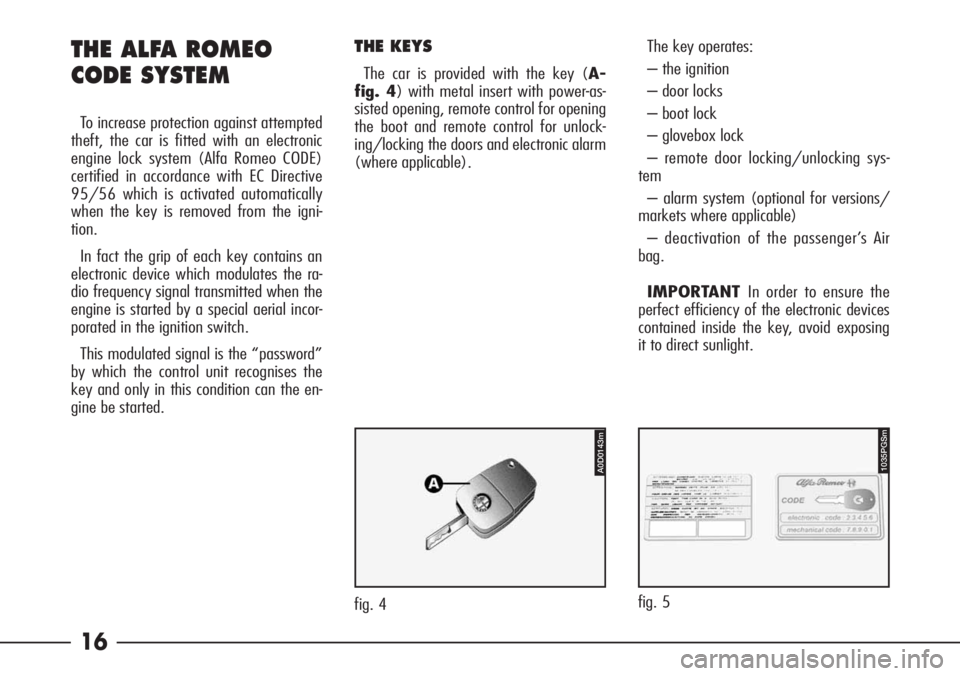
16
1035PGSm
fig. 5
THE ALFA ROMEO
CODE SYSTEM
To increase protection against attempted
theft, the car is fitted with an electronic
engine lock system (Alfa Romeo CODE)
certified in accordance with EC Directive
95/56 which is activated automatically
when the key is removed from the igni-
tion.
In fact the grip of each key contains an
electronic device which modulates the ra-
dio frequency signal transmitted when the
engine is started by a special aerial incor-
porated in the ignition switch.
This modulated signal is the “password”
by which the control unit recognises the
key and only in this condition can the en-
gine be started.
THE KEYS
The car is provided with the key (A-
fig. 4) with metal insert with power-as-
sisted opening, remote control for opening
the boot and remote control for unlock-
ing/locking the doors and electronic alarm
(where applicable). The key operates:
– the ignition
– door locks
– boot lock
– glovebox lock
– remote door locking/unlocking sys-
tem
– alarm system (optional for versions/
markets where applicable)
– deactivation of the passenger’s Air
bag.
IMPORTANT In order to ensure the
perfect efficiency of the electronic devices
contained inside the key, avoid exposing
it to direct sunlight.
A0D0143m
fig. 4
Page 18 of 272
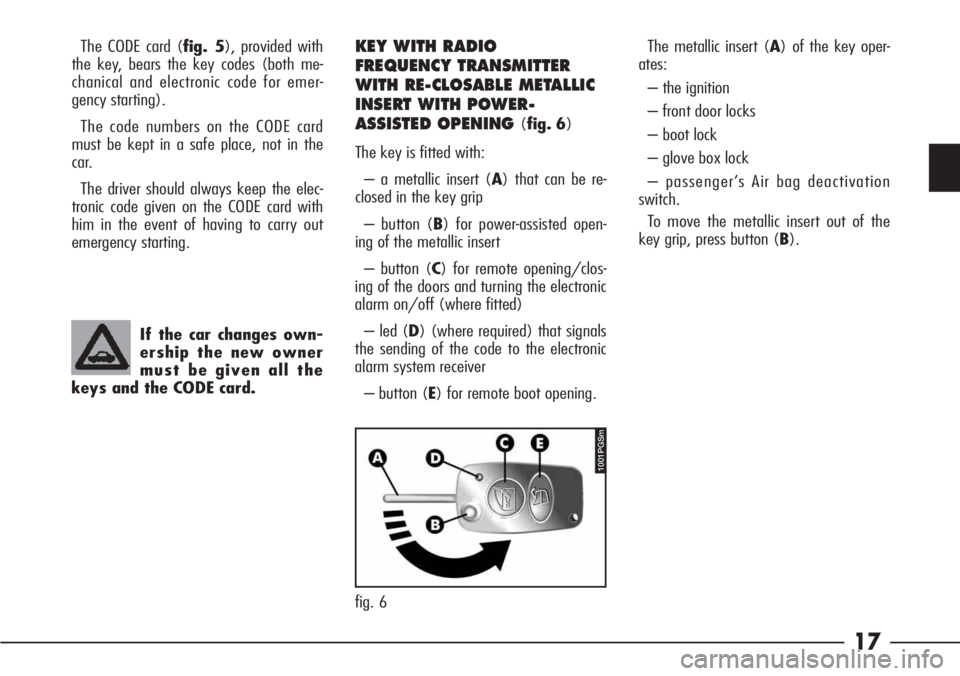
17
KEY WITH RADIO
FREQUENCY TRANSMITTER
WITH RE-CLOSABLE METALLIC
INSERT WITH POWER-
ASSISTED OPENING
(fig. 6)
The key is fitted with:
– a metallic insert (A) that can be re-
closed in the key grip
– button (B) for power-assisted open-
ing of the metallic insert
– button (C) for remote opening/clos-
ing of the doors and turning the electronic
alarm on/off (where fitted)
– led (D) (where required) that signals
the sending of the code to the electronic
alarm system receiver
– button (E) for remote boot opening. The CODE card (fig. 5), provided with
the key, bears the key codes (both me-
chanical and electronic code for emer-
gency starting).
The code numbers on the CODE card
must be kept in a safe place, not in the
car.
The driver should always keep the elec-
tronic code given on the CODE card with
him in the event of having to carry out
emergency starting.
If the car changes own-
ership the new owner
must be given all the
keys and the CODE card.
fig. 6
1001PGSm
The metallic insert (A) of the key oper-
ates:
– the ignition
– front door locks
– boot lock
– glove box lock
– passenger’s Air bag deactivation
switch.
To move the metallic insert out of the
key grip, press button (B).
Page 20 of 272
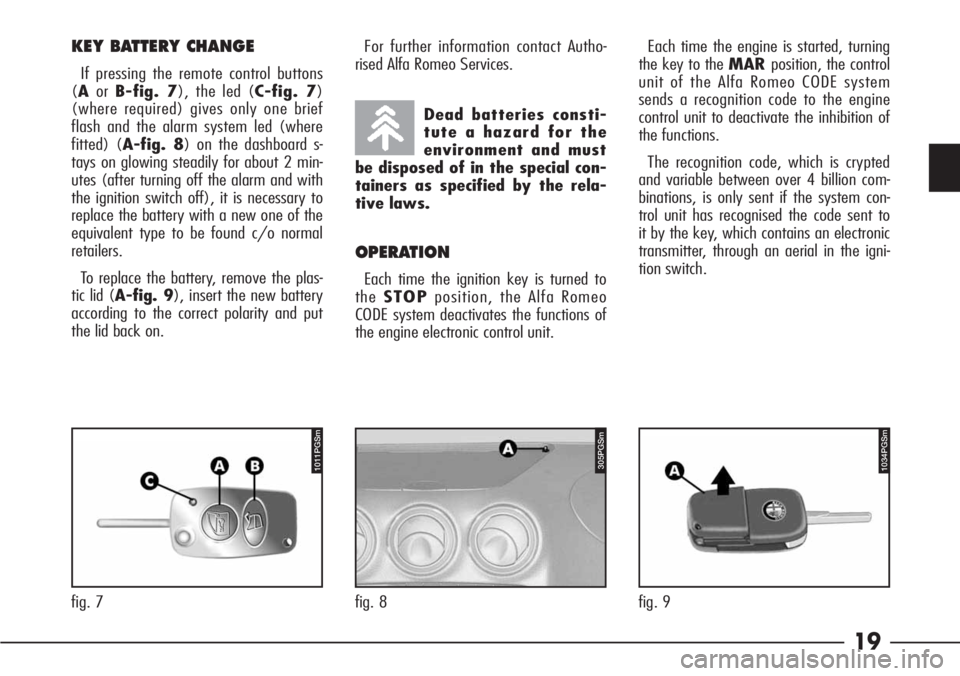
19
KEY BATTERY CHANGE
If pressing the remote control buttons
(AorB-fig. 7), the led (C-fig. 7)
(where required) gives only one brief
flash and the alarm system led (where
fitted) (A-fig. 8) on the dashboard s-
tays on glowing steadily for about 2 min-
utes (after turning off the alarm and with
the ignition switch off), it is necessary to
replace the battery with a new one of the
equivalent type to be found c/o normal
retailers.
To replace the battery, remove the plas-
tic lid (A-fig. 9), insert the new battery
according to the correct polarity and put
the lid back on.For further information contact Autho-
rised Alfa Romeo Services.
OPERATION
Each time the ignition key is turned to
theSTOPposition, the Alfa Romeo
CODE system deactivates the functions of
the engine electronic control unit.Each time the engine is started, turning
the key to the MARposition, the control
unit of the Alfa Romeo CODE system
sends a recognition code to the engine
control unit to deactivate the inhibition of
the functions.
The recognition code, which is crypted
and variable between over 4 billion com-
binations, is only sent if the system con-
trol unit has recognised the code sent to
it by the key, which contains an electronic
transmitter, through an aerial in the igni-
tion switch. Dead batteries consti-
tute a hazard for the
environment and must
be disposed of in the special con-
tainers as specified by the rela-
tive laws.
fig. 7
1011PGSm
fig. 9
1034PGSm
fig. 8
305PGSm
Page 25 of 272
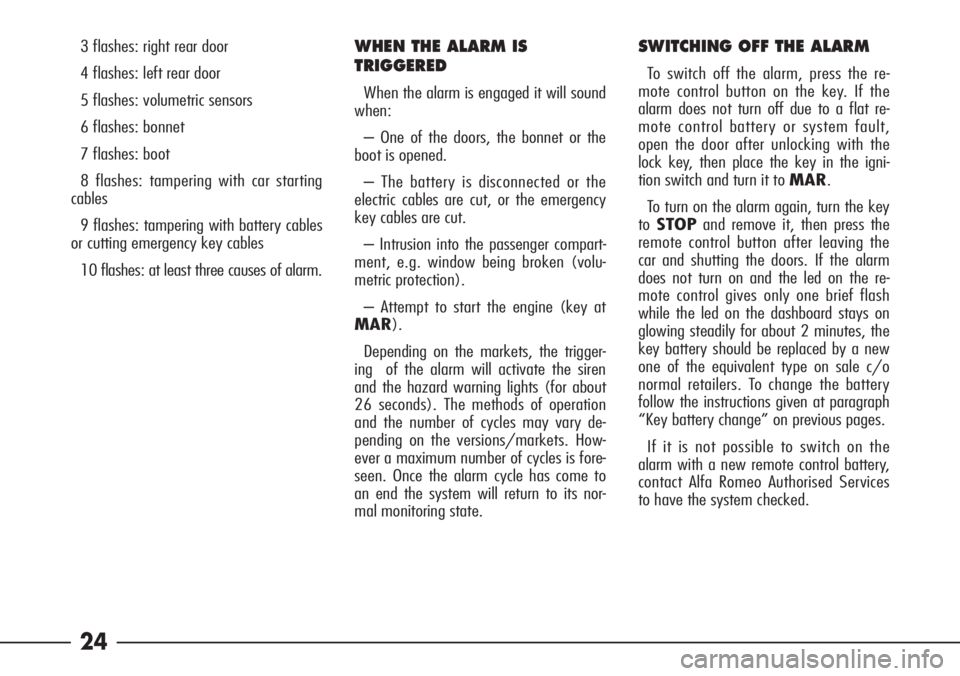
24
3 flashes: right rear door
4 flashes: left rear door
5 flashes: volumetric sensors
6 flashes: bonnet
7 flashes: boot
8 flashes: tampering with car starting
cables
9 flashes: tampering with battery cables
or cutting emergency key cables
10 flashes: at least three causes of alarm.WHEN THE ALARM IS
TRIGGERED
When the alarm is engaged it will sound
when:
– One of the doors, the bonnet or the
boot is opened.
– The battery is disconnected or the
electric cables are cut, or the emergency
key cables are cut.
– Intrusion into the passenger compart-
ment, e.g. window being broken (volu-
metric protection).
– Attempt to start the engine (key at
MAR).
Depending on the markets, the trigger-
ing of the alarm will activate the siren
and the hazard warning lights (for about
26 seconds). The methods of operation
and the number of cycles may vary de-
pending on the versions/markets. How-
ever a maximum number of cycles is fore-
seen. Once the alarm cycle has come to
an end the system will return to its nor-
mal monitoring state.
SWITCHING OFF THE ALARM
To switch off the alarm, press the re-
mote control button on the key. If the
alarm does not turn off due to a flat re-
mote control battery or system fault,
open the door after unlocking with the
lock key, then place the key in the igni-
tion switch and turn it to MAR.
To turn on the alarm again, turn the key
toSTOPand remove it, then press the
remote control button after leaving the
car and shutting the doors. If the alarm
does not turn on and the led on the re-
mote control gives only one brief flash
while the led on the dashboard stays on
glowing steadily for about 2 minutes, the
key battery should be replaced by a new
one of the equivalent type on sale c/o
normal retailers. To change the battery
follow the instructions given at paragraph
“Key battery change” on previous pages.
If it is not possible to switch on the
alarm with a new remote control battery,
contact Alfa Romeo Authorised Services
to have the system checked.
Page 156 of 272
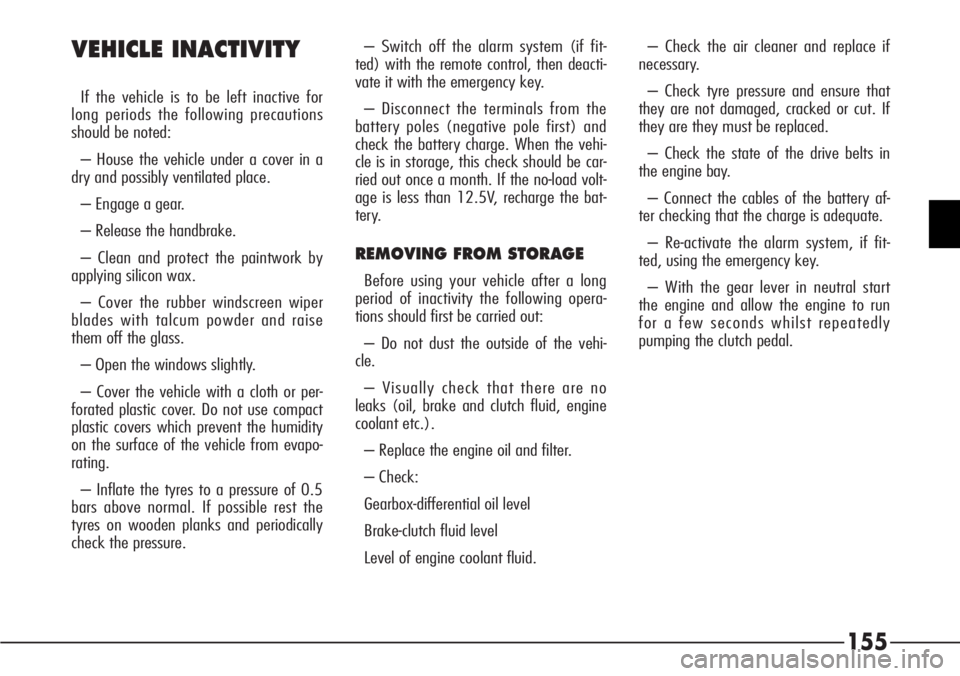
155 VEHICLE INACTIVITY
If the vehicle is to be left inactive for
long periods the following precautions
should be noted:
– House the vehicle under a cover in a
dry and possibly ventilated place.
– Engage a gear.
– Release the handbrake.
– Clean and protect the paintwork by
applying silicon wax.
– Cover the rubber windscreen wiper
blades with talcum powder and raise
them off the glass.
– Open the windows slightly.
– Cover the vehicle with a cloth or per-
forated plastic cover. Do not use compact
plastic covers which prevent the humidity
on the surface of the vehicle from evapo-
rating.
– Inflate the tyres to a pressure of 0.5
bars above normal. If possible rest the
tyres on wooden planks and periodically
check the pressure.– Switch off the alarm system (if fit-
ted) with the remote control, then deacti-
vate it with the emergency key.
– Disconnect the terminals from the
battery poles (negative pole first) and
check the battery charge. When the vehi-
cle is in storage, this check should be car-
ried out once a month. If the no-load volt-
age is less than 12.5V, recharge the bat-
tery.
REMOVING FROM STORAGE
Before using your vehicle after a long
period of inactivity the following opera-
tions should first be carried out:
– Do not dust the outside of the vehi-
cle.
– Visually check that there are no
leaks (oil, brake and clutch fluid, engine
coolant etc.).
– Replace the engine oil and filter.
– Check:
Gearbox-differential oil level
Brake-clutch fluid level
Level of engine coolant fluid.– Check the air cleaner and replace if
necessary.
– Check tyre pressure and ensure that
they are not damaged, cracked or cut. If
they are they must be replaced.
– Check the state of the drive belts in
the engine bay.
– Connect the cables of the battery af-
ter checking that the charge is adequate.
– Re-activate the alarm system, if fit-
ted, using the emergency key.
– With the gear lever in neutral start
the engine and allow the engine to run
for a few seconds whilst repeatedly
pumping the clutch pedal.
Page 194 of 272

193
System/Component Fuse no. Ampere Location
Rearscreen heating 1 30A fig. 93
Relay coil T21, T22, T23 (boot box) 3 5A fig. 86
Relay coil T24 (boot box) 5 10A fig. 86
Remote control receiver 15 10A fig. 93
Sound amplifier 20 25A fig. 93
Sound system 4 15A fig. 86
Sound system controls on steering wheel 5 10Afig. 86
Starter motor 1 30A fig. 89
Trailer presetting 12 10A fig. 93
Windscreen heating 7 15A fig. 93
Windscreen wiper 14 25A fig. 86
System/Component Fuse no. Ampere Location
Navigator 18 5A fig. 86
Parking sensors (control unit) 15 10A fig. 93
Power windows (driver's control
LOCK warning light) 15 10A fig. 93
Powered sunroof 10 20A fig. 93
Presetting 4 – fig. 93
11 – fig. 93
Rain sensor 15 10A fig. 93
Rear current socket 16 20A fig. 93
Rear LH power window (ABI control unit) 14 20Afig. 93
Rear RH power window (ABI control unit) 17 20Afig. 93
Page 222 of 272
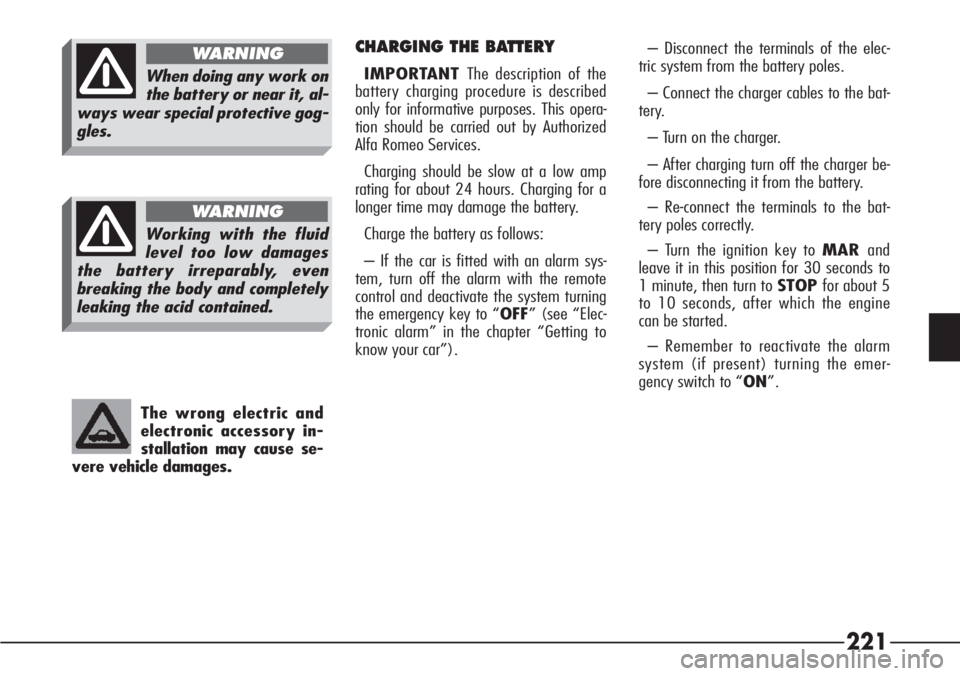
221
CHARGING THE BATTERY
IMPORTANT The description of the
battery charging procedure is described
only for informative purposes. This opera-
tion should be carried out by Authorized
Alfa Romeo Services.
Charging should be slow at a low amp
rating for about 24 hours. Charging for a
longer time may damage the battery.
Charge the battery as follows:
– If the car is fitted with an alarm sys-
tem, turn off the alarm with the remote
control and deactivate the system turning
the emergency key to “OFF” (see “Elec-
tronic alarm” in the chapter “Getting to
know your car”).– Disconnect the terminals of the elec-
tric system from the battery poles.
– Connect the charger cables to the bat-
tery.
– Turn on the charger.
– After charging turn off the charger be-
fore disconnecting it from the battery.
– Re-connect the terminals to the bat-
tery poles correctly.
– Turn the ignition key to MARand
leave it in this position for 30 seconds to
1 minute, then turn to STOPfor about 5
to 10 seconds, after which the engine
can be started.
– Remember to reactivate the alarm
system (if present) turning the emer-
gency switch to “ON”.
The wrong electric and
electronic accessory in-
stallation may cause se-
vere vehicle damages.When doing any work on
the battery or near it, al-
ways wear special protective gog-
gles.
Working with the fluid
level too low damages
the battery irreparably, even
breaking the body and completely
leaking the acid contained.
WARNING
WARNING
Page 266 of 272
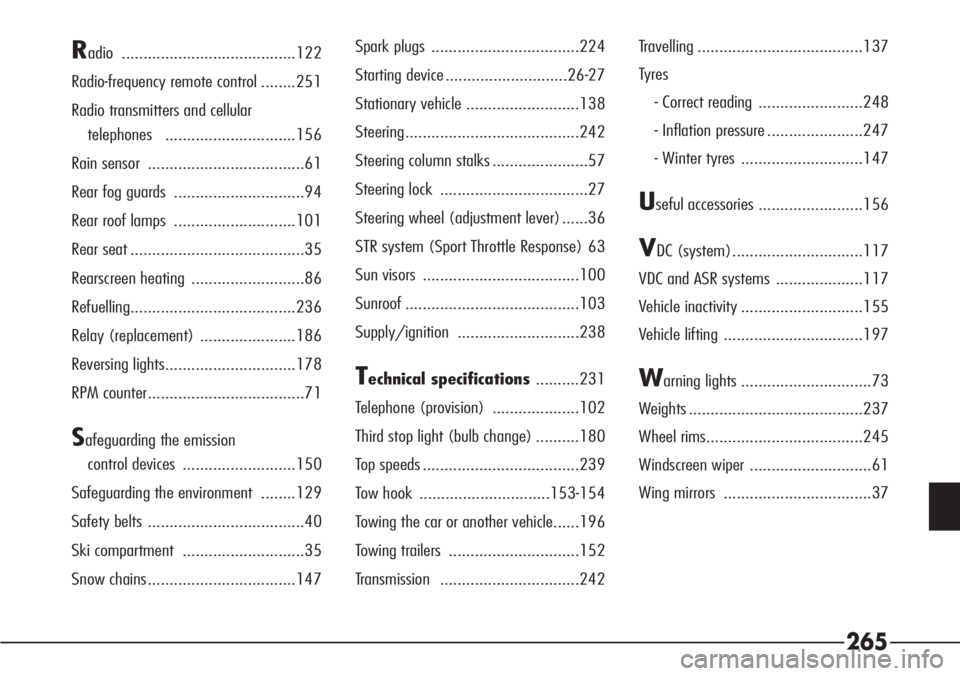
265
Radio ........................................122
Radio-frequency remote control ........251
Radio transmitters and cellular
telephones ..............................156
Rain sensor ....................................61
Rear fog guards ..............................94
Rear roof lamps ............................101
Rear seat ........................................35
Rearscreen heating ..........................86
Refuelling......................................236
Relay (replacement) ......................186
Reversing lights..............................178
RPM counter....................................71
Safeguarding the emission
control devices ..........................150
Safeguarding the environment ........129
Safety belts ....................................40
Ski compartment ............................35
Snow chains..................................147Spark plugs ..................................224
Starting device ............................26-27
Stationary vehicle ..........................138
Steering........................................242
Steering column stalks ......................57
Steering lock ..................................27
Steering wheel (adjustment lever) ......36
STR system (Sport Throttle Response) 63
Sun visors ....................................100
Sunroof ........................................103
Supply/ignition ............................238
Technical specifications..........231
Telephone (provision) ....................102
Third stop light (bulb change) ..........180
Top speeds ....................................239
Tow hook ..............................153-154
Towing the car or another vehicle......196
Towing trailers ..............................152
Transmission ................................242Travelling ......................................137
Tyres
- Correct reading ........................248
- Inflation pressure ......................247
- Winter tyres ............................147
Useful accessories ........................156
VDC (system)..............................117
VDC and ASR systems ....................117
Vehicle inactivity ............................155
Vehicle lifting ................................197
Warning lights ..............................73
Weights ........................................237
Wheel rims....................................245
Windscreen wiper ............................61
Wing mirrors ..................................37